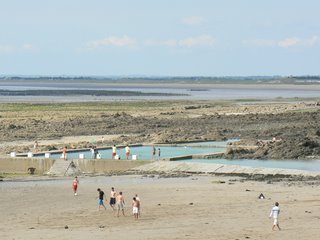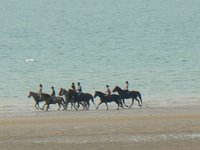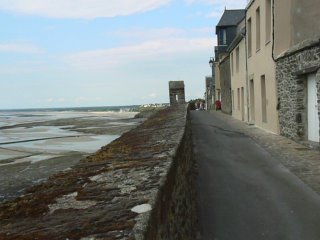Coming Back to Gritty, Salty Granville
 We arrived in Granville, on a spit of land jutting out just above the famous Mt. St. Michel on France’s coast. I came here when I was 16, traveling Europe in a group trip with other kids, and I stood on a corner and recognized a gauzy, hazy memory…a movie theater once stood in a building that is now a casino overlooking the vast lowtide that stretched out for a thousand yards. I told my guides and they laughed, ‘you’re right, it was a theater,’ and I marveled at how long ago it was that I came here and retained memories of this gritty old seafarer’s town of about 15,000.
We arrived in Granville, on a spit of land jutting out just above the famous Mt. St. Michel on France’s coast. I came here when I was 16, traveling Europe in a group trip with other kids, and I stood on a corner and recognized a gauzy, hazy memory…a movie theater once stood in a building that is now a casino overlooking the vast lowtide that stretched out for a thousand yards. I told my guides and they laughed, ‘you’re right, it was a theater,’ and I marveled at how long ago it was that I came here and retained memories of this gritty old seafarer’s town of about 15,000.
Our accommodations here are first rate–a modern Ibis hotel beside a bustling marina, surrounded by a wall that shows the remarkable tides, which rise qnd fall about 20 feet. “It’s dangerous, because people c an get caught off guard,” said our guides, “everyone plans their beach trips depending on the tides, and so do the boaters.” The yachts can’t get out during low tide, and the soccer player’s field and the wide open expanse where people gallop horses is gone as well.
an get caught off guard,” said our guides, “everyone plans their beach trips depending on the tides, and so do the boaters.” The yachts can’t get out during low tide, and the soccer player’s field and the wide open expanse where people gallop horses is gone as well.
Granville is a seafarer’s town with a fleet of boats and the local specialties are bulot, snails, scallops, dorade and skate. It was settled in the 1400s by English who wanted to use the city to plan an attack on the fortified Mt. St. Michel, which was still held by the French. They didn’t succeed. Way off in the distance, dark patches on the beach were mussell farms. A local specialty is oysters with camenbert, which doesn’t sound very appealing.
Both Normandy and B rittany fight over who actually owns Mt St. Michel, the number one tourist spot in France after Paris. A river that separates the two provinces is being diverted, to avoid the erosion and build up of sand. So soon, the river will flow equally around it, so it will be even more difficult to decide whether it’s in Brittany or Normandy.
rittany fight over who actually owns Mt St. Michel, the number one tourist spot in France after Paris. A river that separates the two provinces is being diverted, to avoid the erosion and build up of sand. So soon, the river will flow equally around it, so it will be even more difficult to decide whether it’s in Brittany or Normandy.
